Opal Tower investigation reveals where it all went wrong

An independent report commissioned by the NSW Government into the Opal Tower’s structural deficiencies has found that inferior building material and a number of structural and design issues were to blame for the apartment complex’ structural damage.
On Christmas Eve last year, residents of the 36-level Sydney Olympic Park building were evacuated from the complex over concerns about cracking noises and cracks in the walls.
Residents of nearly 100 apartments were eventually told in early February that they could return home, but about 150 of the building’s 392 units remain unoccupied while others refuse to return.
The Opal Tower scandal has prompted calls to strengthen standards in the industry and has sent the prices of nearby apartments plummeting.
The NSW government called an independent investigation into the matter, headed by three of NSW’s best engineers.
“Our final report confirms that a number of structural design and construction issues, including non-compliance with national codes and standards were responsible for the observed damage at Opal Tower,” the engineers wrote in their report.
What was wrong with the building?
The report found that horizontal support beams were “under-designed”, not compliant, “susceptible to failure” and prone to bursting, while other parts of the tower used “lower-strength concrete”.
“We found some of the as-constructed hob beams and panel assemblies were under-designed according to the National Construction Code and Australian Standards,” professors Mark Hoffman, John Carter and Stephen Foster said.
Testing also showed lower-strength concrete was used in some beams on level four, which “likely precipitated the observed major damage”.
Aside from poor quality construction materials, other causes also contributed to the damage.
Notably, human error was partially to blame, with the report citing “poor quality workmanship or errors during construction” as well as “flaws or errors in the design of the structural systems”.
Is it that the end of that?
Despite the structural issues, the Opal Tower isn’t a write-off; Hoffman, Carter and Forster indicated that the building was salvageable.
“We consider that the building is overall structurally sound and the localised damage to the building can be rectified to ensure the building is compliant with the National Construction Code.
“We agree in principle with the rectification works planned to date, noting that these have advanced considerably since our interim report was released,” they said.
“However, we repeat our call for qualified structural engineers to check the final design and construction proposals in detail before major rectification works begin and before the building is deemed completely safe for occupancy, while noting the reoccupation of the building extends beyond the scope of our investigation and is a matter for residents and the builder.”
Where to from here?
The engineers’ report recommended creating databases of registered engineers and NSW building certifications, along with a building structure review board to monitor known property design flaws and shape future building codes.
NSW minister for better regulation Matt Kean said that the state government had “already committed” to the recommendation to create a database of registered engineers.
NSW government will also appoint a Building Commissioner and ensure building practitioners owe homeowners a duty of care.
“We will be working through the detail of today’s report with our new Building Commissioner to make sure that when homeowners are handed over the keys to a new building, it is safe, structurally sound and free from major defects,” Kean said.
–with AAP
Make your money work with Yahoo Finance’s daily newsletter. Sign up here and stay on top of the latest money, news and tech news.
Now read: House prices could halve in property ‘bloodbath’
Now read: Buyer beware: These are Australia’s 16 worst-performing suburbs
Now read: Approvals for foreign investment in Australia’s housing market plunge again

 Yahoo Finance
Yahoo Finance 
